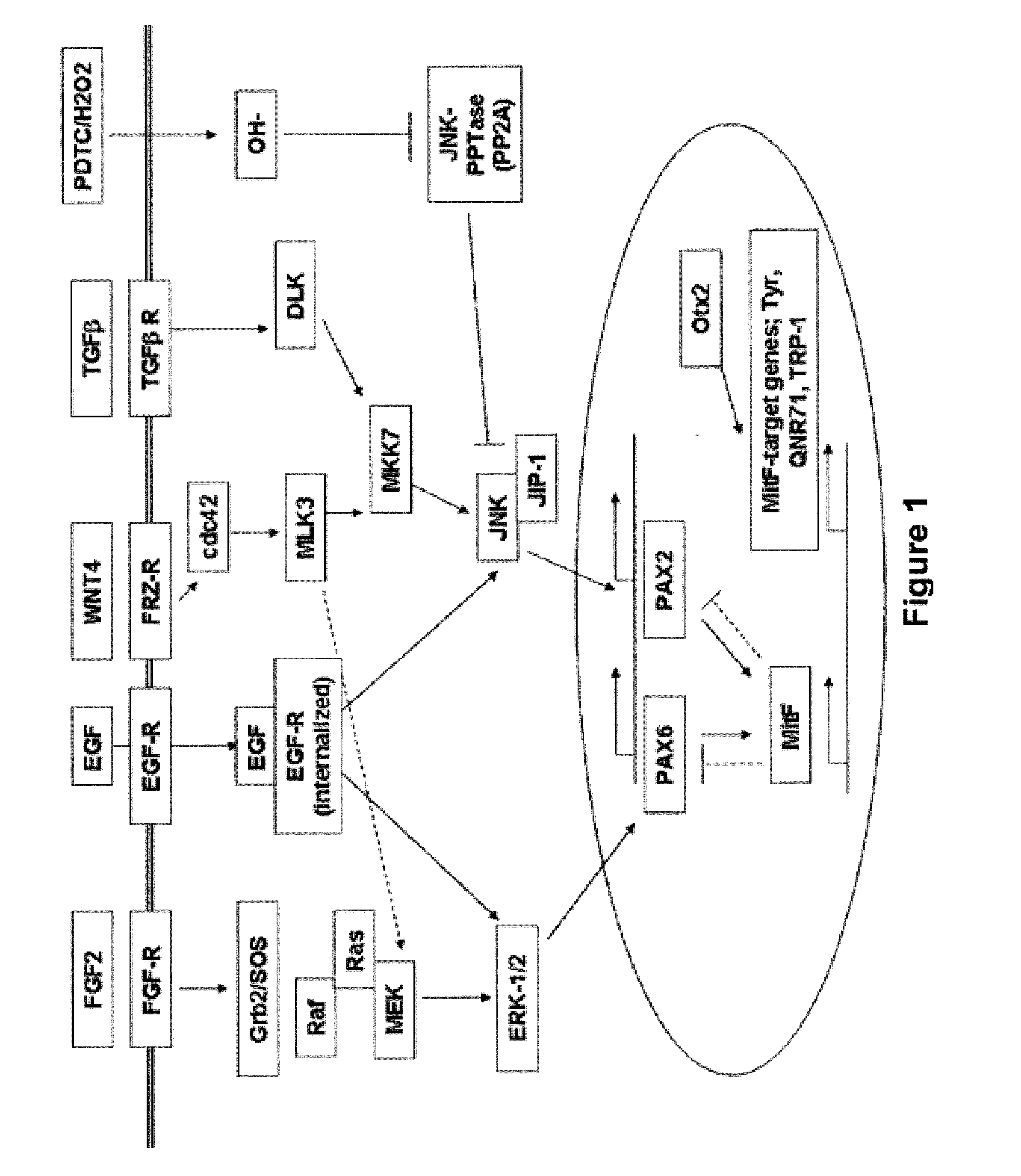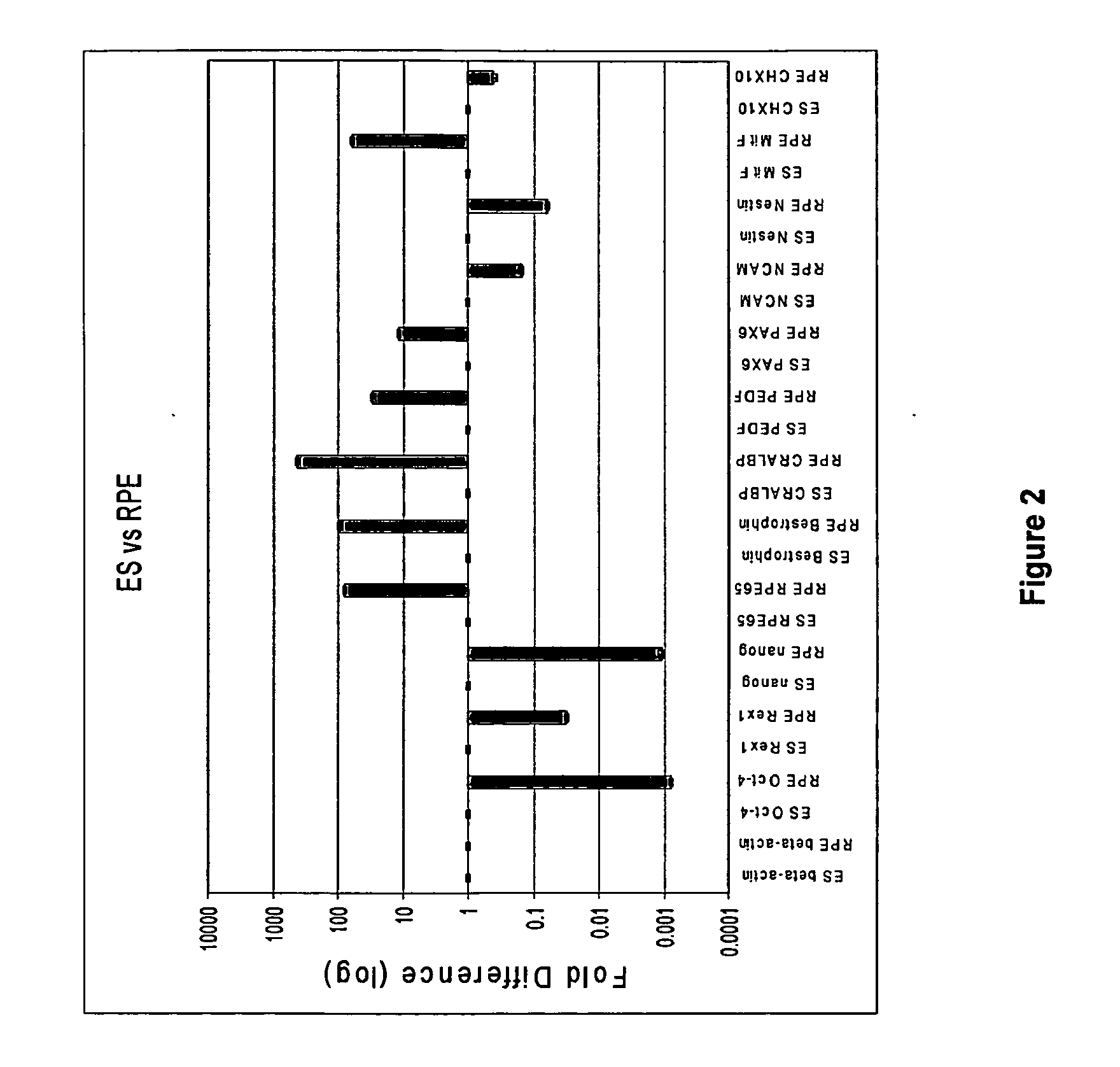Methods of producing rpe cells and compositions of rpe cells
a technology of rpe cells and compositions, applied in the direction of drug compositions, biocide, cardiovascular disorders, etc., can solve the problems of macular degeneration, serious consequences of thinning of the retina, etc., and achieve the effect of maximizing the likelihood of cell survival and reducing the risk of cell damag
- Summary
- Abstract
- Description
- Claims
- Application Information
AI Technical Summary
Benefits of technology
Problems solved by technology
Method used
Image
Examples
example 1
RPE Differentiation and Culture
[0214]Cryopreserved hES cells were thawed and placed into suspension culture on Lo-bind Nunclon Petri dishes in MDBK-Growth Medium (Sigma—SAFC Biosciences) or OptimPro SFM (Invitrogen) supplemented with L-Glutamine, Penicillin / Streptomycin, and B-27 supplement. The hES cells had been previously derived from single blastomeres biopsied from early cleavage stage human embryos. The remainder of the human embryo was not destroyed. Two hES cell line derived from single blastomeres were used—MA01 and MA09. The cells were cultured for 7-14 days as embryoid bodies (EBs).
[0215]After 7-14 days, the EBs were plated onto tissue culture plates coated with gelatin from porcine skin. The EBs were grown as adherent cultures for an additional 14-28 days in MDBK-Growth Medium or OptimPro SFM supplemented with L-Glutamine, and Penicillin / Streptomycin, without B-27 supplement.
[0216]From amongst the cells in the adherent culture of EBs, RPE cells become visible and are rec...
example 2
RPE Isolation and Propagation
[0217]As differentiated RPE cells continue to appear in the adherent cultures, clusters of differentiated RPEs become visibly noticeable based on cell shape. Frozen collagenase IV (20 mg / ml) was thawed and diluted to 7 mg / ml. The collagenase IV was applied to the adherent culture containing RPE clusters (1.0 ml to each well in a 6-well plate). Over approximately 1-3 hours, the collagenase IV dissociated the cell clusters. By dissociating the RPE clusters from other cells in the culture, an enriched suspension of RPE cells was obtained. The enriched RPE cell suspension was removed from the culture plate and transferred to a 100 mm tissue culture dish with 10 ml of MEF medium. Pigmented clumps are transferred with a stem cell cutting tool (Swemed-Vitrolife) to a well of a 6-well plate containing 3 ml of MEF media. After all clumps have been picked up, the suspension of pigmented cells is transferred to a 15 ml conical tube containing 7 ml of MEF medium and...
example 3
RPE-Specific mRNA Expression Measured by Quantitative, Real-Time, Reverse Transcription PCR (qPCR)
[0220]In order to characterize developmental stages during the human embryonic stem cell (hES) differentiation process into retinal pigmented epithelium (RPE) several assays have been employed to identify the expression levels of genes key to each representative stage of development. qPCR was developed to provide a quantitative and relative measurement of the abundance of cell type-specific mRNA transcripts of interest in the RPE differentiation process. qPCR was used to determine genes that are uniquely expressed in human embryonic stem cells, in neuroretinal cells during eye development, and in RPE cells differentiated from human embryonic stem cells. The genes for each cell type are listed below in Table 1.
TABLE 1Genes specific to hES, neuroretina / eye, and hRPE cellshESc-SpecificNeuroectoderm / NeuroretinaRPE-Specific GenesOct-4 (POU5F1)CHX10PAX-6NanogNCAMPAX-2Rex-1NestinRPE-65TDGF-1Be...
PUM
| Property | Measurement | Unit |
|---|---|---|
| temperature | aaaaa | aaaaa |
| temperature | aaaaa | aaaaa |
| temperature | aaaaa | aaaaa |
Abstract
Description
Claims
Application Information
 Login to View More
Login to View More - R&D
- Intellectual Property
- Life Sciences
- Materials
- Tech Scout
- Unparalleled Data Quality
- Higher Quality Content
- 60% Fewer Hallucinations
Browse by: Latest US Patents, China's latest patents, Technical Efficacy Thesaurus, Application Domain, Technology Topic, Popular Technical Reports.
© 2025 PatSnap. All rights reserved.Legal|Privacy policy|Modern Slavery Act Transparency Statement|Sitemap|About US| Contact US: help@patsnap.com



